
Virunga Volcanoes in the border-triangle between Rwanda, Uganda and the DR Congo / guenterguni
Gorilla trekking represents one of the most unforgettable adventures, allowing intrepid travellers to connect with these magnificent creatures in their natural habitat. With only a few countries offering this unique experience, Uganda’s Bwindi Impenetrable Forest and Rwanda’s Volcanoes National Park stand out as two premier destinations, each bringing its own charm and challenges to the trekking experience.
Both locations are famous for their endangered mountain gorillas. However, they have different geography, accessibility, and cultural experiences. Knowing the differences between these two parks can help adventurers choose the best trek and maximize their chances of seeing these amazing animals.
This blog is a friendly guide comparing gorilla trekking in Uganda and Rwanda. We’ll cover costs, preparation, accommodation, and wildlife viewing opportunities. By the end, you’ll have a clear understanding of what each destination offers for an unforgettable experience.
Highlights of Gorilla Trekking
Gorilla trekking in Uganda and Rwanda offers an unparalleled opportunity to witness the majestic mountain gorillas in their natural habitat, making it a highlight for wildlife enthusiasts and adventurers alike.
In Uganda, the experience is centred around Bwindi Impenetrable National Park, where visitors embark on thrilling hikes through dense forests to encounter these endangered creatures up close. Meanwhile, Rwanda’s Volcanoes National Park provides a similarly immersive experience, with stunning views of the Virunga Mountains enhancing the adventure.
Both countries offer not only gorilla encounters but also opportunities to track golden monkeys and explore vibrant local cultures. The lush landscapes and rich biodiversity of these regions further elevate the trekking experience, making it an unforgettable journey into the heart of Africa’s wildlife.
Key Differences between Bwindi Impenetrable Forest and Volcanoes National Park
Gorilla enthusiasts debating between trekking in Bwindi Impenetrable Forest National Park and Volcanoes National Park may find themselves weighing several key differences that affect the overall experience. Perhaps the most significant distinction lies in the number of habituated gorilla families accessible to visitors. With 22 families ready for human interaction, Bwindi offers more gorilla tracking options compared to the 12 families of Volcanoes National Park.
Additionally, the vegetation within these parks greatly impacts the trekking experience. In Volcanoes National Park, open bamboo forests provide clearer visibility which may shorten trekking time and offer easier photography opportunities. In contrast, the dense tropical rainforest of Bwindi, with its complexity and thicker undergrowth, presents a more challenging but equally remarkable environment to observe these primates.
Regardless of these differences, both parks promise an awe-inspiring encounter with mountain gorillas. Now let’s delve into the location and geography of each park to further distinguish these two captivating destinations.
Location and Geography
The remote Bwindi Impenetrable Forest National Park, ensconced in the southwestern corner of Uganda, forms a frontier with the Democratic Republic of Congo. Covering a substantial 321-square-kilometer area, it is segmented into four sectors dedicated to gorilla trekking and the gorilla habituation experience. This rugged expanse is also known for its vast biodiversity, including numerous bird species.
Conversely, Volcanoes National Park lies in the striking shadows of the Virunga Mountain range located in northwestern Rwanda. Approximately 105 kilometers from Kigali, the bustling Rwanda’s capital, Volcanoes National Park is closer to an international airport than Bwindi.
Accessibility and Transportation
When it comes to accessibility, Volcanoes National Park has a clear advantage for many travellers. Approximately 116 kilometers from Kigali International Airport, a mere 2 to 3 hour drive stands between visitors and the start of their gorilla adventure.
On the other hand, Bwindi Impenetrable Forest National Park, which lies 462 kilometers from Entebbe International Airport, requires a longer commitment for those coming by road. The travel time ranges between 9-10 hours. For those who prefer comfort over long drives, there is the luxurious option of chartering a one-hour flight from Entebbe directly into Bwindi, greatly reducing travel time.
Bwindi Impenetrable National Park was previously perceived as less accessible due to the lengthy drive from Entebbe International Airport. However, there are new itineraries offering a four to five-hour route from Kigali to Bwindi Impenetrable National Park, making it more accessible for travellers.
Ultimately, while both parks offer the life-changing experience of gorilla trekking, accessibility and geography play critical roles in shaping the journey for each visitor.
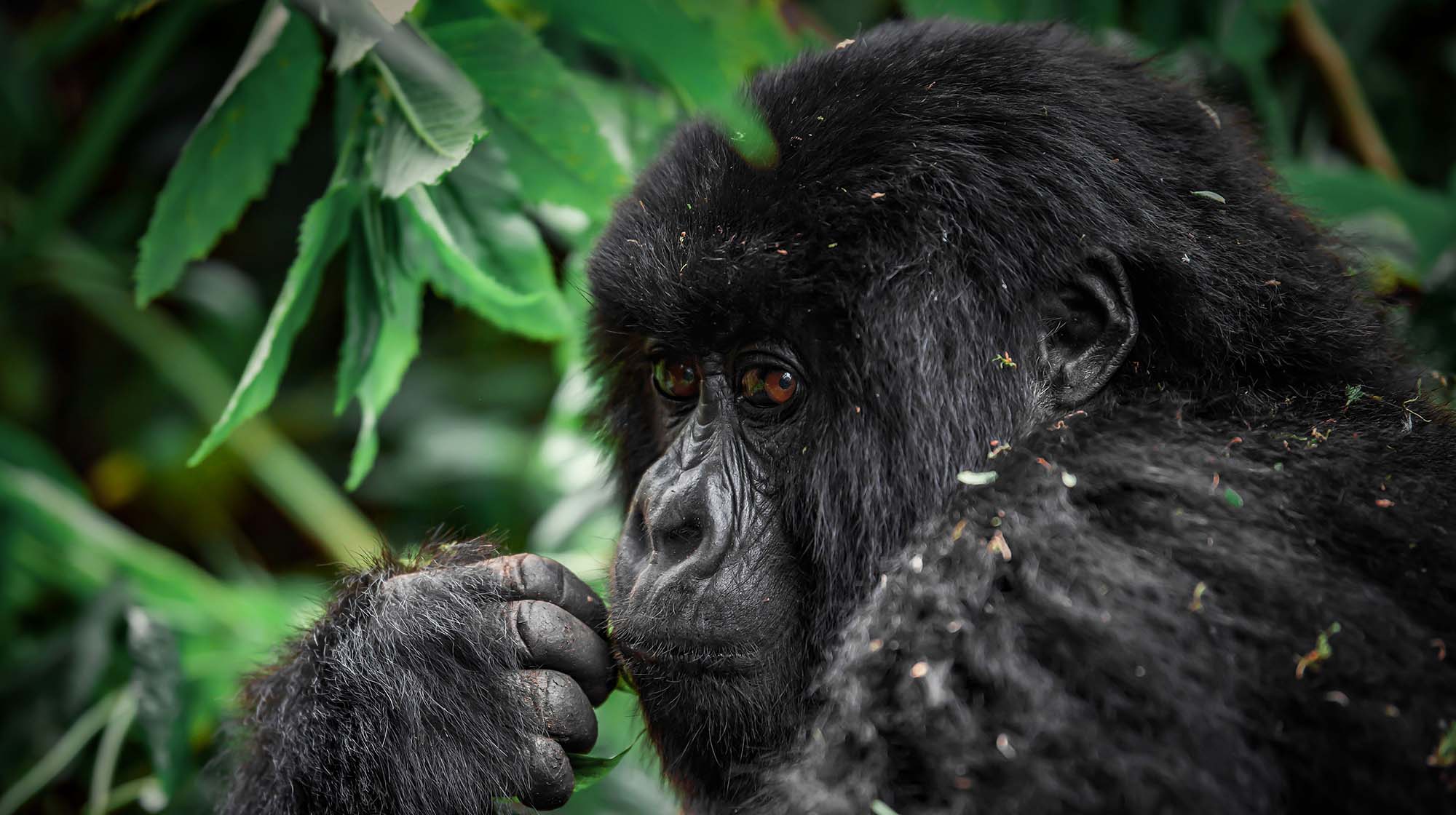
African Gorilla, Volcanoes National Park, Rwanda / Jeremy Stewardson
Costs of Gorilla Permits
One important factor in planning a gorilla trekking adventure is the cost of the necessary permits. These permits are essential for the conservation efforts, limiting the number of daily visitors to protect the habitat of the mountain gorillas.
These permits are issued on a first-come, first-served basis. In terms of availability, Bwindi Impenetrable National Park offers more than 170 gorilla permits for daily trekking, whereas Volcanoes National Park has around 96 permits available each day.
Permit Prices in Uganda
Uganda’s Bwindi Impenetrable National Park and Mgahinga Gorilla National Park provide an affordable entry into the world of gorilla trekking with permits costing USD800 for foreign non-residents.
Uganda offers a special gorilla habituation experience. This allows you to spend four hours with the gorillas instead of the usual one hour. There are 15 habituated gorilla groups open to visitors. Because of this, permits are very popular. To secure your spot, it’s best to book at least six months in advance. For foreign non-residents, the price is set at USD1,500 per person.
Permit Prices in Rwanda
Rwanda positions itself as offering a premium, luxurious gorilla trekking experience, which is evident in its pricing strategy for permits. At USD1,500 each, these permits are among the priciest in the world. Rwanda’s higher permit costs reflect a conservation strategy to manage and restrict the number of visitors to the fragile environments of these primates.
The price reflects both the exclusivity of the experience and the conservation efforts, with the revenue being directed back into the protection of the gorillas and community development. In Rwanda, daily permits are intentionally limited to minimize the impact on the habitats of the Virunga Mountain gorillas. This not only enhances the experience by ensuring less crowding but also aligns with Rwanda’s strategy of high-value, low-impact tourism.
Overall, the costs of gorilla permits in both Uganda and Rwanda emphasize the balance between providing an awe-inspiring experience to visitors and the imperative of sustaining the mountain gorilla populations in their natural environments.

Gorilla eating in the wild / Jeremy Stewardson
Best Time for Gorilla Trekking
When planning a gorilla trekking adventure, timing is crucial. The best periods for this exhilarating activity are during the dry seasons. These peak trekking times are also when the demand for permits is at its highest.
Seasonal Considerations
If you’re eager to embark on a gorilla trekking adventure in Uganda or Rwanda, timing your visit is key. The dry seasons, which span from June to September and December to February, are typically the best times for trekking. During these months, you’ll find that there is less rainfall. The trails are drier and much easier to navigate. This makes hiking a lot more enjoyable! Tracking gorillas becomes simpler too because their locations are more predictable. Plus, it’s easier to take clear photos without mist or overgrown plants getting in the way.
Conversely, the wet seasons—April, May, and November—present a different set of challenges. Trails can be slippery and muddy due to frequent showers. However, these months reward hikers with stunningly vibrant landscapes. Plus, there are fewer visitors, allowing for smaller, more intimate trekking groups.
Mountain gorillas live in rainforests, so you can expect some rain throughout the year. However, gorilla trekking is available year-round. You can enjoy this incredible experience in any season!

Baby gorilla takes a ride on their mother’s back / Jeremy Stewardson
Gorilla Families: Availability and Viewing
Gorilla trekking is a thrilling experience for wildlife lovers and adventurers. Bwindi Impenetrable Forest National Park in Uganda and Volcanoes National Park in Rwanda are the best places to see these gentle giants. The number and makeup of gorilla groups can vary. Births, deaths, and gorillas changing groups all contribute to these changes.
Number of Gorilla Groups in Bwindi
At the heart of Uganda’s conservation success is Bwindi Impenetrable Forest National Park, a safe haven for an impressive number of habituated gorilla families. With 19 habituated gorilla groups, Bwindi holds the prestigious title of the highest number of such groups in a single park worldwide. Visitors are likely to catch sight of these magnificent creatures, as 15 of these groups are open for touristic tracking.
The gorilla families are evenly spread across four major sectors: Buhoma, Ruhija, Rushaga, and Nkuringo. This spread enhances the chances of visitors encountering gorillas, regardless of their specific location within the park. To ensure an intimate and minimal disturbance to the gorillas’ natural behavior, trekking groups in Bwindi are limited to eight members per group.
Number of Gorilla Groups in Volcanoes National Park
In contrast, Rwanda’s pride, Volcanoes National Park, offers its own unique charm with 12 habituated gorilla families. Though fewer in number compared to Bwindi, the experience of tracking gorillas such as the famous Susa, Amahoro, Karisimbi, and others, provides an unforgettable adventure.
Trekking in Volcanoes National Park offers a unique chance to see fascinating gorilla families. The park is also rich in history and conservation efforts. Dian Fossey’s work played a big role in this. Her legacy is still felt throughout the park. Hiking here gives you a closer look at these incredible primates and the important conservation work that saved them.

People Taking Photos
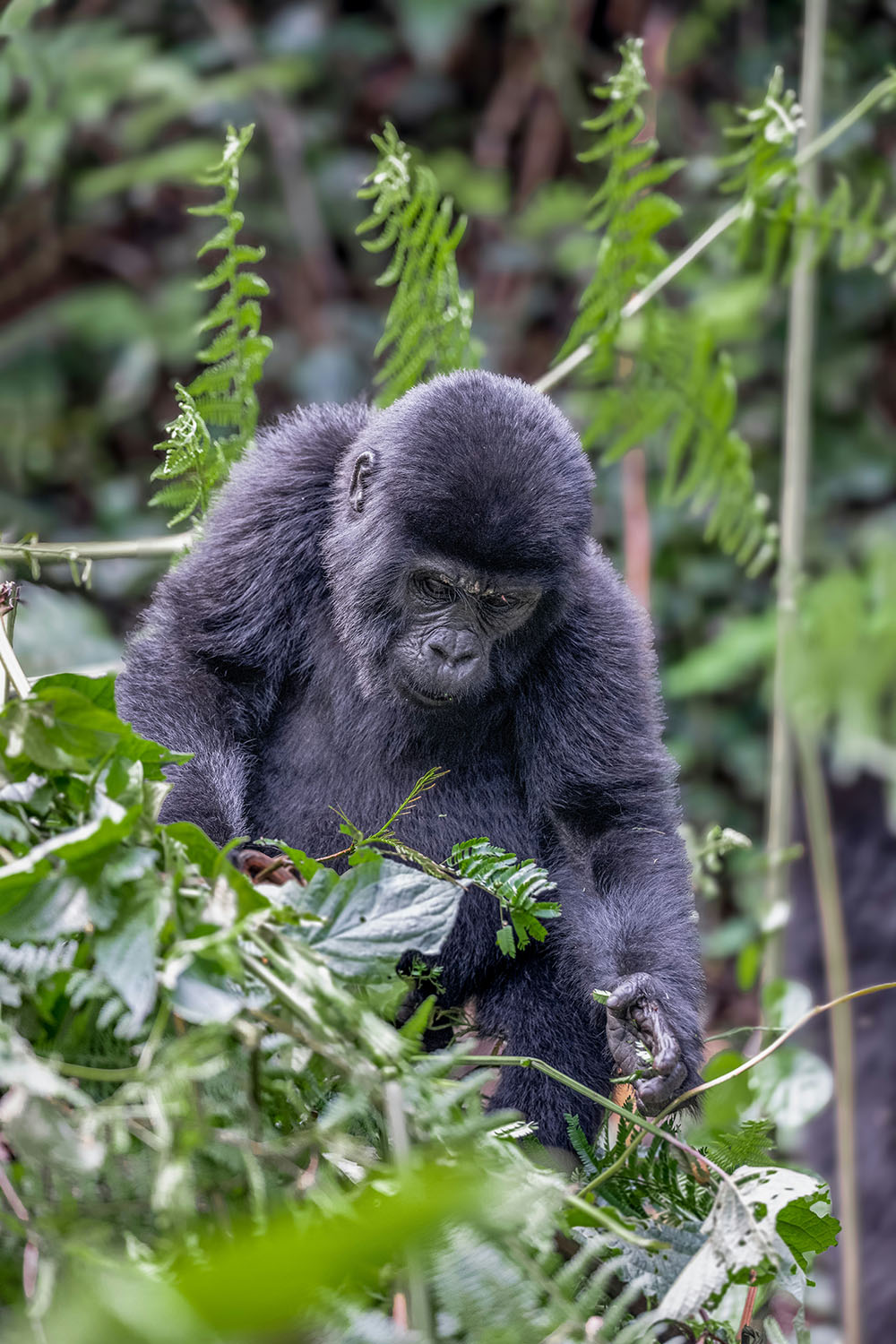
Bwindi Impenetrable National Park, Uganda / Matt Bango
Gorilla Habituation Experiences in Bwindi Impenetrable National Park
Gorilla habituation experiences in Uganda’s Bwindi Impenetrable Forest offer a unique chance to see mountain gorillas up close. Only four participants can join each session, which lasts an incredible four hours with semi-habituated gorilla families. This experience is much longer than the usual one-hour gorilla trekking.
Guided by skilled researchers and park rangers, these sessions play a crucial role in the three-year process of training wild gorillas to become accustomed to the presence of humans.. Visitors get to watch fascinating gorilla behaviors and take amazing photos and videos.
Not only is this a special way to learn about mountain gorillas, but it also supports important conservation and research efforts in Bwindi Impenetrable Forest.

Golden Monkey / Magdalena Kula Manchee
Accommodation Options
Gorilla trekking is an extraordinary adventure, and where you stay can deeply enhance this immersive experience. Both Uganda’s Bwindi Impenetrable National Park and Rwanda’s Volcanoes National Park offer a range of accommodation options that cater to the different needs and budgets of trekkers from across the globe.
Lodging in Bwindi Impenetrable Forest
Bwindi Impenetrable National Park offers a range of lodging options for visitors looking to experience the mountain gorilla habitat. For those seeking luxury, the Bwindi Lodge stands out as one of the most opulent accommodations within the park. Guests are treated to personal butler service, a cozy open fireplace in the main lounge, and a spa seamlessly integrated into the surrounding forest. Clouds Mountain Gorilla Lodge, located in the southern area of Bwindi National Park, provides a comfortable and upscale stay, complete with stunning views of the Virunga Mountains. Another high-end choice is the Sanctuary Gorilla Forest Camp, known for its spacious and inviting rooms, an open-plan main area, and a communal fire pit that enhances the evening ambiance.
For travellers looking for mid-range options, Buhoma Lodge is a favoured selection, ideally located just five minutes from the Buhoma gorilla trekking trailhead. It features ten comfortable cottages, each equipped with en-suite bathrooms and private verandas, allowing guests to enjoy the natural beauty of the park. Similarly, Mahogany Springs Safari Lodge offers a more simplistic yet charming experience, nestled beside the Munyanga River in the heart of the park.
Lodging in Volcanoes National Park
Rwanda is renowned for its luxurious lodges near Volcanoes National Park, offering a unique blend of comfort and stunning natural beauty. One great choice is Sabyinyo Silverback Lodge. It’s a classic, elegant lodge owned by the community, located at the foothills of the Virungas. It’s just ten minutes from the Park Headquarters, at an altitude of 7,000 feet, helping guests acclimatize for their gorilla treks.
Another excellent option is Singita Kwitonda. It features sustainable practices and a bold, modern design, right on the edge of Volcanoes National Park. For a special experience, check out Bisate Lodge. Its thatched cabins are inspired by Rwandan culture and have private verandahs with stunning forest views. The One&Only Gorilla’s Nest offers modern cabins made of wood and volcanic stone, set against the beautiful Virunga Mountains.
Lastly, Virunga Lodge offers amazing panoramic views and lovely stone bandas. It embodies timeless African elegance and supports local community projects. The eco-friendly lodge has a central area for the reception and restaurant, all with breathtaking views over Lakes Ruhondo and Bulera, as well as the Virunga Volcanoes. Each lodge provides a fantastic base for an unforgettable gorilla trekking adventure in Rwanda!
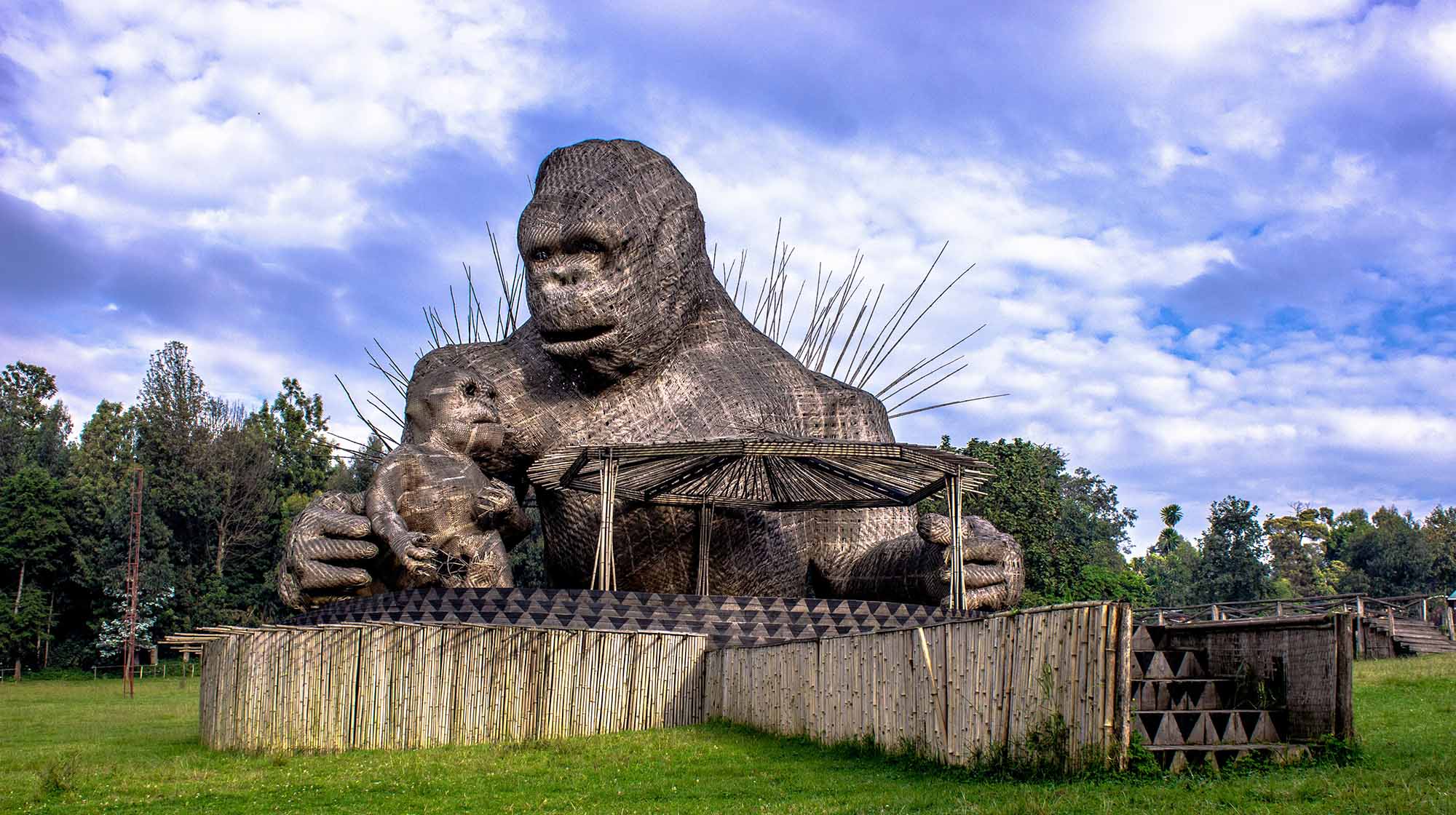
Volcanoes National Park, Musanze, Rwanda / Murenzi Emery
Local Community Interactions
Gorilla trekking in Uganda and Rwanda is an amazing adventure! When you combine it with cultural experiences, it’s even more rewarding. You’ll learn about local communities and their connection to the gorillas and their habitat. This makes your safari feel more meaningful. Plus, it helps support local communities and conservation efforts too!
Cultural Experiences in Uganda
Gorilla trekking in Uganda is an exciting experience that includes vibrant cultural expressions. Traditional dances and performances often happen before the treks in Volcanoes National Park. These lively shows build anticipation for meeting the mountain gorillas, showcasing the local community’s connection to these amazing animals.
The local culture is evident in the friendly interactions and cozy lodging options around Bwindi Impenetrable National Park. Visitors enjoy warm Ugandan hospitality, which enhances their overall experience. Whether starting or finishing a trek, stories and local folklore shared by community members create lasting memories.
For those interested in the culture, village walks and community activities provide a great insight into daily life and traditions in Uganda. These experiences deepen the connection felt during the gorilla treks, offering a fuller understanding of Uganda’s rich essence.
Cultural Experiences in Rwanda
Rwanda has a unique cultural landscape that offers great experiences for visitors to Volcanoes National Park. While it may differ from the Batwa communities near Bwindi, it’s charming in its own way. You can enjoy community walks and forest explorations to see the daily lives of locals near the Virunga Mountains.
Tourists who want a deeper cultural experience can take the Batwa trail or visit the Ib’yacwu Cultural Village. These activities showcase Rwanda’s rich culture, with traditional dances and performances that highlight its heritage.
A trip to Ruhengeri allows visitors to connect closely with local culture. Community tours reveal the essence of Rwandan life, from the people and their crafts to the rhythms of rural living, enhancing the gorilla trekking experience with the warmth of Rwandan culture.
In Uganda and Rwanda, gorilla trekking is more than just nature. It includes encounters with local communities that enrich the experience. Each step leads you through stunning landscapes and vibrant cultures. Together, they create an unforgettable adventure!
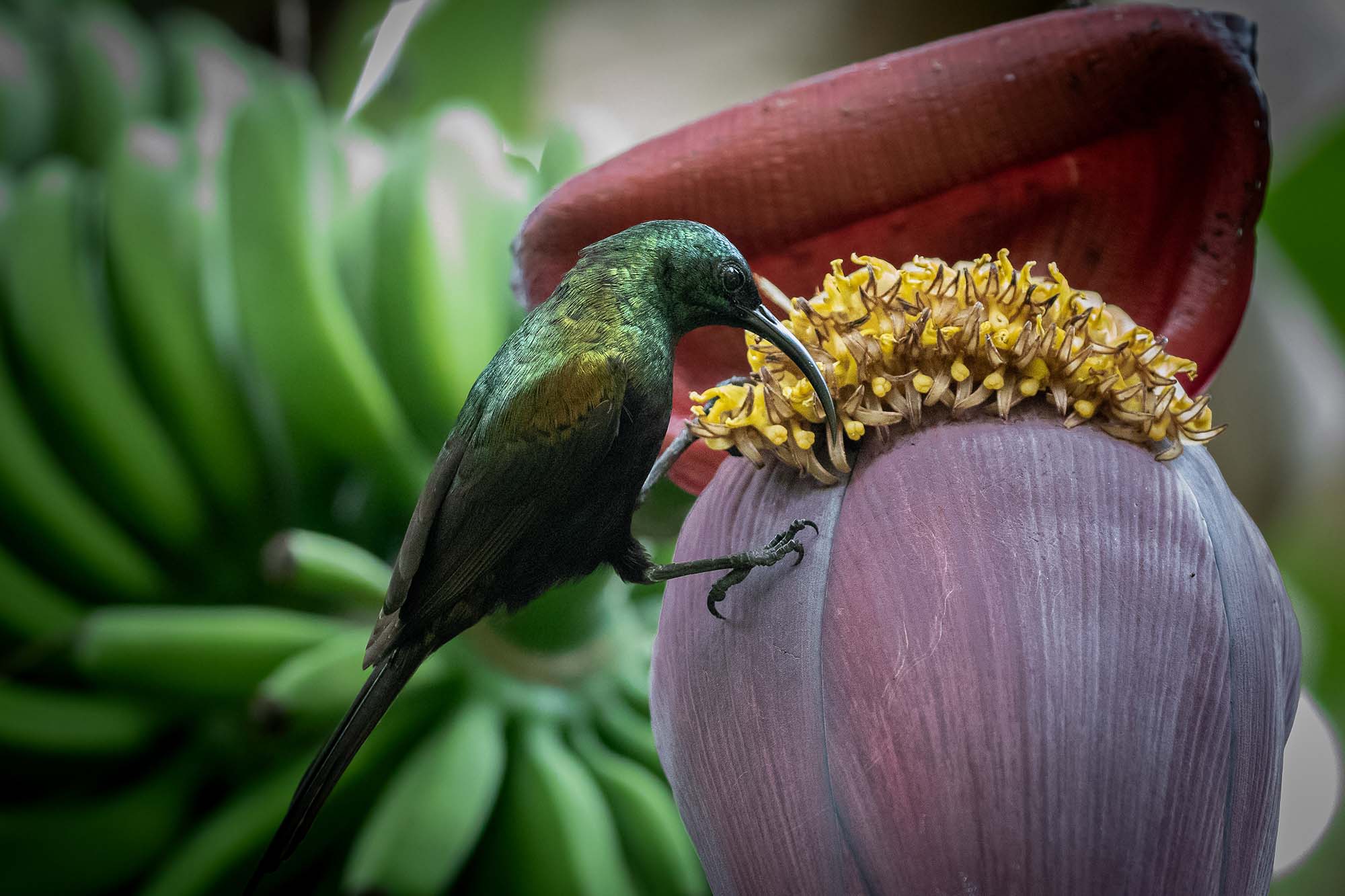
Bronzy sunbird feeding on banana blossom outside Bwindi Impenetrable Forest / Pedro Ferreira do Amaral

Chimpanzee On A Tree
Wildlife Viewing Opportunities
While mountain gorillas are the most famous inhabitants of Bwindi Impenetrable Forest in Uganda and Volcanoes National Park in Rwanda, these protected areas offer numerous other wildlife viewing opportunities.
Other Primate Species in Bwindi
Bwindi Impenetrable Forest stands out as one of the rare locations on Earth where you can witness both mountain gorillas and chimpanzees in their natural surroundings. These dynamic great apes coexist within an extraordinarily diverse ecosystem that supports a rich tapestry of primate life.
Among the leafy branches and bustling forest floor, you might spot several other primate species that call this forest home. The area is a refuge for baboons, whose amusing antics are a favorite among visitors. Blue monkeys, with their gentle demeanor, and red-tailed monkeys, easily identified by their rosy-hued tails, add to the primate variety seen in the forest.
The tranquil L’Hoest’s monkeys and buoyant vervet monkeys share this habitat, along with the intriguing nighttime calls of bush babies. The stunning black and white colobus monkeys, with their flowing white tails, provide an arresting sight amid the dense green of Bwindi’s rainforest.
Bwindi is a birdwatcher’s paradise
Bwindi is a also fantastic place for birdwatchers! It is home to more than 350 bird species. You can see the African green broadbill, Grauer’s swamp warbler, and Shelley’s crimsonwing. There are also many unique species from the Albertine Rift.
Other Wildlife in Volcanoes National Park
In Rwanda, Volcanoes National Park is synonymous with mountain gorillas, thanks to the pioneering work of Dian Fossey and the fame of “Gorillas in the Mist.” Yet, it is also a sanctuary for the captivating golden monkeys, a species endangered and treasured by wildlife devotees. Spotting these vibrant primates is a special treat, their golden fur a shimmering standout against the park’s rich greenery.
Additionally, the park is home to a diversity of monkey species that enrich the wildlife viewing experience. From the silver monkeys to vervet monkeys and the lesser-known Dents monkeys, these intelligent creatures offer captivating behavior and interaction opportunities not to be missed.
Birdwatching is also a major attraction within Volcanoes National Park. Birds such as the majestic long-crested eagle and the colourful Rwenzori turaco can be spotted among a host of other avian species that add to the park’s ornithological appeal. The park’s varied ecosystems, spanning bamboo forests to alpine meadows, create a favorable environment for a multiplicity of wildlife species.
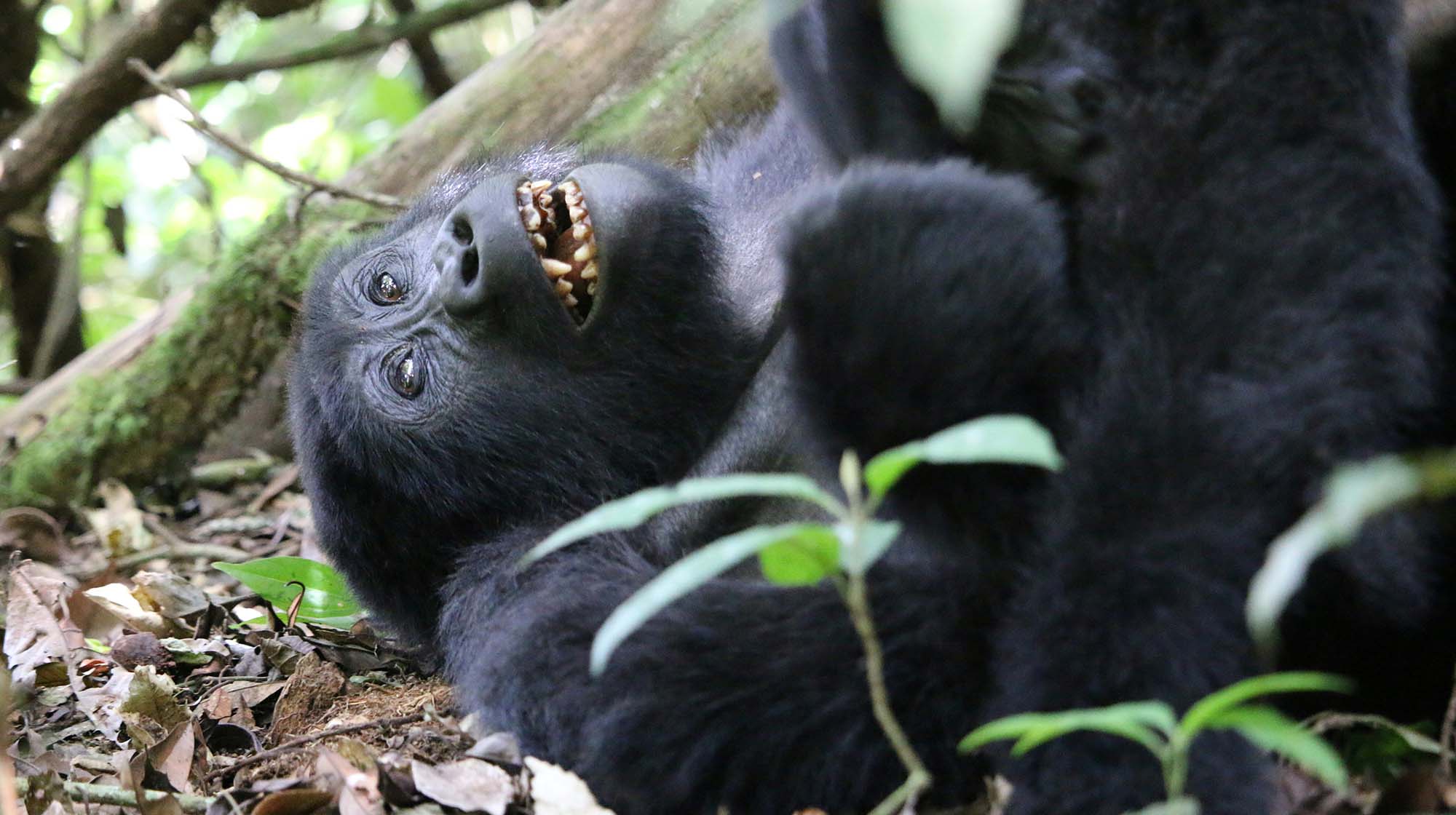
Baby gorilla lying on its back in the forest / Gabriel Schumacher
Preparations for Gorilla Trekking
Going on a gorilla trekking adventure is exciting! To make the most of your experience, you need to prepare well. Whether you’re headed to Bwindi Impenetrable National Park in Uganda or the slopes of Rwanda’s Volcanoes National Park, knowing what to expect is important.
Physical Preparations
Gorilla trekking is an exhilarating adventure that demands proper physical preparation to ensure a safe and enjoyable experience. You’ll need to navigate steep slopes and rough paths, especially when it’s rainy.
Get ready by improving your fitness. Start with some cardiovascular activities. Go for regular walks and slowly increase your distance. Add jogging to improve your heart and lung health. Cycling and swimming are excellent for overall fitness too! Do squats and lunges to strengthen your legs. Don’t forget to stretch or try yoga for better flexibility. If you can, practice hiking on uneven trails or stairs. This will help you prepare for your trek!
Gear Recommendations
Gorilla trekking in Africa is an exciting adventure. To make the most of it, it’s important to pack the right gear. This will ensure a safe and enjoyable experience.
The terrain in Bwindi Impenetrable Forest and Volcanoes National Park can be challenging. It’s important to wear sturdy hiking boots with good ankle support. This will help you navigate the trails. The areas where you’ll be gorilla trekking are often muddy and wet. That’s why waterproof shoes are a must! They’ll keep your feet dry and comfy as you walk through the damp forest trails.
Given the variable climate at high elevations, dressing in layers becomes indispensable. Starting with base layers to keep you dry and adding insulating layers for warmth, you can adapt to the changing conditions easily. Yet, when moving through this lush ecosystem, long-sleeved shirts and trousers are more than a comfort—they’re a shield against the forest’s brambles and biting insects.
Rain in these rainforest locations can be a sudden surprise, making waterproof attire and protective zip bags for your electronics non-negotiable items. Additionally, a walking stick can be invaluable to provide extra support on muddy and slippery paths.
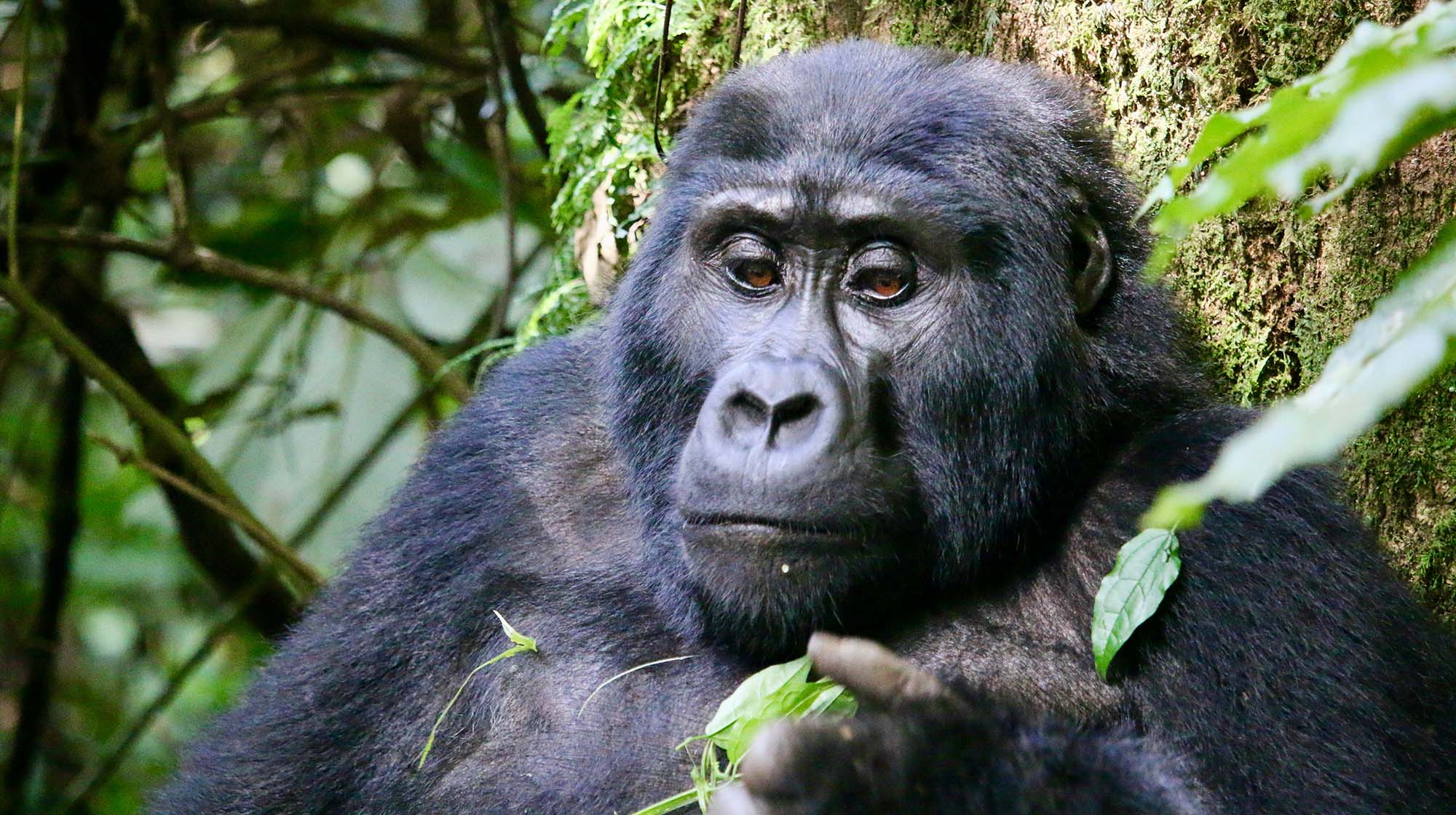
Endangered Mountain Gorilla in Bwindi Impenetrable Forest, Uganda / Gabriel Schumacher
Advantages of Using a Tour Operator for Gorilla Trekking in Rwanda and Uganda
Planning a gorilla trekking itinerary in Uganda or Rwanda can be an exhilarating experience, but the intricacies involved can often be overwhelming. Here’s why utilizing a tour operator is highly advantageous:
1. Expertise and Experience
Tour operators specializing in gorilla trekking possess extensive knowledge of the regions, including the best trekking routes and gorilla families to visit. Their experience ensures you maximize your chances of seeing these magnificent creatures up close, often with a 99% sighting guarantee.
2. Permit Acquisition
Securing gorilla trekking permits can be a complex process due to high demand and limited availability. Established tour operators handle the acquisition of permits seamlessly. They are familiar with the booking systems and can navigate any potential challenges, saving you time and stress.
3. Comprehensive Itineraries
Tour operators can create tailored itineraries that include not only the gorilla trekking experience but also additional activities such as nature walks, bird watching, and cultural tours. They help design a well-rounded adventure that captures the essence of both Uganda and Rwanda, ensuring you don’t miss out on any highlights.
4. Logistics and Transportation
Travelling to remote locations like Bwindi Impenetrable Forest or Volcanoes National Park can be daunting. Tour operators manage all logistics, including transportation, which ensures comfortable travel and timely arrivals for your treks.
5. Accommodation Arrangements
Finding suitable accommodation can be challenging, especially in remote areas with limited options. Tour companies typically have established relationships with local lodges and hotels, ensuring you receive the best options that fit your budget and preferences. They may also secure better rates due to established partnerships.
6. Safety and Support
Traveling in unfamiliar territories poses potential risks. Using a tour operator ensures that you are guided by experienced professionals who prioritize your safety and well-being. They are knowledgeable about the local terrain and any safety protocols, giving you peace of mind during your trek.
7. Cultural Insights and Local Interaction
Tour operators often provide opportunities for cultural exchanges with local communities. This enhances your overall experience, allowing you to learn about the local culture, traditions, and conservation efforts directly from the people whose lives are intertwined with gorilla conservation.
8. Time Efficiency
Planning a trip independently can be time-consuming, particularly with the various components involved—from obtaining permits to arranging transportation and lodging. Tour operators streamline this process, allowing you to save time and focus on enjoying your gorilla trekking adventure.
9. Post-Trek Activities
After a thrilling gorilla trekking experience, many operators offer additional excursions, such as hikes to the Dian Fossey tomb or visits to local crafts markets. This means that your trip can be filled with enriching experiences beyond just tracking the gorillas
10. Post-Trek Activities
If you want to combine your Ugandan or Rwandan adventure with other African destinations, they can help! Enjoy a luxurious safari in Tanzania, relax on beautiful beaches in Zanzibar, or discover the famous wine regions of South Africa. They’ll create a seamless tour that that matches your desires.
Planning a gorilla trekking experience on your own is possible. However, using a tour operator offers great benefits. They can help with securing permits and provide expert guidance. Plus, they manage all the logistics for you. For a seamless experience, consider contacting a reputable company to help you create the perfect itinerary for your gorilla trekking safari.
